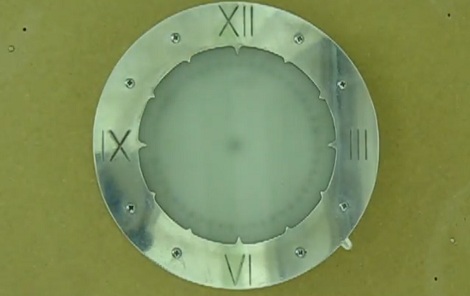Hack A Day’s own [Jack Buffington] finally finished the solar clock he built for the buildlounge.com laser cutter giveaway.
[Jack] has been putting up the build log on his blog, and now the project is finally complete. The clock operates entirely on solar power. Instead of fancy-smanchy electronics, this clock puts a new spin on the very old school sundial. A box outside [Jack]’s house captures sunlight and focuses it onto an array of optical fibers. These fibers transmit the sunlight though the wall and to the face of the clock. Only a portion of the fibers are lit at any one time, and these correspond to the time of day. With a lot of confusing fiber routing, the clock can indicate the time of day by lighting up the clock face.
We covered the nascent beginnings of this project when it was still a glimmer in [Jack]’s eye, and we’ve got to hand it to him. This is a really creative project, and the addition of the ‘daylight savings time lever’ is the icing on the cake. Check out the video after the break for a great explanation of how the clock actually works, and be sure to check out the project on BuildLounge.
[youtube=http://www.youtube.com/watch?&v=ijMOdhYEILA&w=470]

















It needs an Arduino to take in effect the equation of time.
i have alot more respect for this guy and his problem solving skills after seeing this. nice one jack, what a cool project!
Trav, oh shut up with your stupid adruno comment.
It was just in jest and I hope it doesn’t start a flame war. I can see the both sides of using or not using an Arduino in a project.
I really like that this one is not electronic. But you do have to take into account the Equation of time, or else your sundial can be off by as much as 14 min. depending on the time of year.
Too bad there is no video of it in operation. set up a time lapse camera or even walk by and press the shutter once every 10 minutes.
Oh it’s partially in the video, I skipped past all the boring talk trying to find it.
He really needs to put it at the beginning or end as many just want to see it work and not all the borink yack yack yack about how it was built.
Truth. I have this problem with my videos, too. I’ve been told, and it’s a valid point; show off your stuff first. Discuss it later.
agreed fartface. the time lapse should be in the beginning and his descriptions should be clearer (less “uhh” moments) and generally faster.
:30-1:00 is the timelapse… or were you referring to something else?
Maybe he updated the video after your comment?
thats a good one …..
This is pretty awesome!
I think you just have to put the hole in the center of half a circle and the fibers go on the circle. That’s how spherical sundails work.
Many years ago, Scientific American held a contest to design a digital sundial.
Apparently, you can now buy one:
http://www.digitalsundial.com
This is really terrific. Well done, Jack. Perhaps a higher-tech version could have a matrix of phototransistors (or a ccd?), along with a uC to interpret the data and drive a display. Then you could compensate for all the effects of latitude, season, etc in software. Now that I think about it, maybe this whole thing could be done with a hacked digital camera and a fisheye lens. Anyways, I like your low tech version. Very cool.
“Then you could compensate for all the effects of latitude, season,”
Could you do this by using the change in apparent elevation of the sun to illuminate a second, third, etc set of fibers over the year? A clever curved slot in the box?